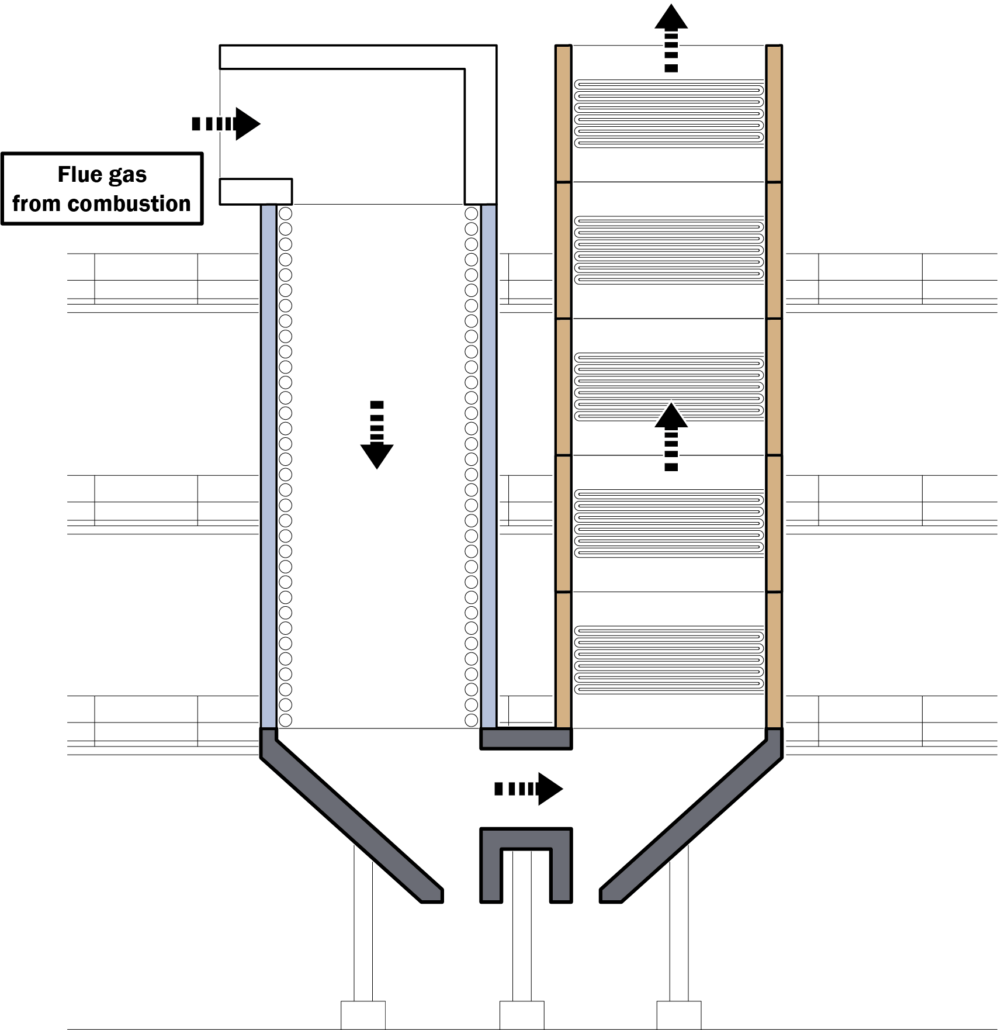Efficient radiation section
The radiation section is a compromise consisting of the thermodynamic, optimum heat transfer and low wear and equipped with highly reliable sealing material
Biomass plants use organic solid fuels such as sawdust, wood chips, timber or landscape management by products to produce hot flue gases. Biomass is an excellent alternative to generating heat using conventional fossil fuel products. Depending on their quality, these solid biomass fuels can create high demands on a plant. The combustion process, the heating components and the legal and emission regulations must be considered.
Many biomass burning plants have been built since the end of the 90s as a measure to end dependence on fossil fuels. Many plants constructed early on have ongoing issues with the two and three-pass heaters. Recurring ash is a major reason heaters require frequent cleaning – up to six times a year. This cleaning operation requires the plant to be shut down. The ash is also a solid material that in certain conditions (ex: high flow rate) can take on abrasive properties and over time, the tube coil can be damaged. Over a period of time, the abrasion from ash causes a reduction in wall thickness of the tube coil and holes will eventually form. In the worst case, a fire will occur. At the minimum, extensive repairs will be required for proper and safe operation.
NESS is proud to offer a complete biomass burning plant using trusted partners. We can implement grate-fired, dust-fired or underfeed-fire options. We design our plants for simple cleaning and minimal abrasion. Our special design directly discharges ash and pollution created long-term, efficient and easy-to-maintain operations. We always focus on the thermal oil component of a plant by producing a complete thermal oil management system including expansion and collection vessel, pumping stations, heat exchangers, economizers, air-preheaters, emergency coolers, switch cabinets and more.
Efficient separation of ash and particles is possible due to the separation of the heater in radiation. Longer periods between maintenance intervals are possible because much of the arising debris can be directly separated, thus requiring less cleaning.
NESS offers benefits of a balanced temperature profile and high performance refractory materials as a result of the quality heaters NESS is known for. The convection section is built for a long lifetime as special protective shells are installed to protect the heat exchangers from wear. Cleaning abilities are also enhanced in the radiation sections.
Three-pass heaters fired with biomass are certainly an option. NESS has optimized this three-pass design specifically for this purpose further minimizing abrasion and pollution. A three-pass heater makes sense for smaller plants with a performance range up to 4mW. This solution from an investment perspective is 10-15% cheaper than a separated radiation and convection configuration. With a three-pass system, several areas must be considered. With the higher quality of biomass, less ash is produced and thus less cleaning and maintenance is required. This pays off for smaller plants. However, when using materials from landscape management or A3 timber category, it is nearly impossible to operate a plant efficiently with a three-pass system and thus we recommend our two-stage system.
Compared to three-pass heaters, NESS radiation sections consists of only one tube coil. This is because the highest rates of flow occurs on the return section of the three-pass heaters and this is where the highest wear happens. This is often overlooked in older plants so NESS offers a solution integrated in to the convection section to provide the ultimate economic solution.
NESS convection sections in the second and third pass of a traditional three-pass heater are optimized for minimal wear and easy maintenance. The compromise between good heat transfer and low abrasion has been eliminated by the unique meander-shaped heater batteries that only allow flue gases to pass in one direction. This two-part concept is a reliable advantage for larger plants using grades of biomass with unpredictable quality.
Designed specifically for ORC plants, NESS offers the two-stage economizer with high-temperature (HT)-ECO and low-temperature (LT)-ECO respective sections of the turbine. The result is a highly efficient ORC process in the heating system.
The NESS high-performance emergency cooler is equipped with a large cooling surface that provides assured safety should there be a failure in the main plant. The cooler is equipped with an automatic fill level controller and is protected from corrosion. The cooler is integrated into the primary circuit of the thermal oil system and at low load, can be used as an optional process cooler.
We at NESS set out not only to plan and produce new plants including the engineering but also to examine existing plants for potential improvements to enhance safety, to increase cost-effectiveness or to improve efficiency. We also arrange maintenance works that are to be done regularly. Do not hesitate to contact us.
Functionality Biomass plants:

radiation section
ash hopper
convection sections
You need to load content from reCAPTCHA to submit the form. Please note that doing so will share data with third-party providers.
More InformationYou are currently viewing a placeholder content from Facebook. To access the actual content, click the button below. Please note that doing so will share data with third-party providers.
More InformationYou are currently viewing a placeholder content from Instagram. To access the actual content, click the button below. Please note that doing so will share data with third-party providers.
More InformationYou need to load content from reCAPTCHA to submit the form. Please note that doing so will share data with third-party providers.
More InformationYou are currently viewing a placeholder content from Turnstile. To access the actual content, click the button below. Please note that doing so will share data with third-party providers.
More InformationYou are currently viewing a placeholder content from X. To access the actual content, click the button below. Please note that doing so will share data with third-party providers.
More Information